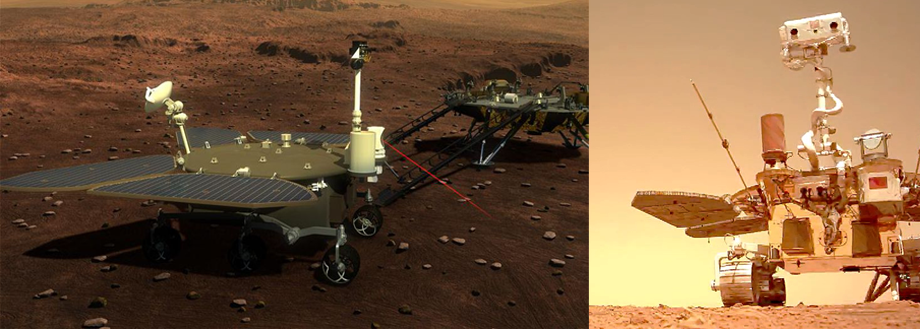 Title: The jubilant technical team from China National Space Administration (CNSA) celebrate the successful landing of Zhurong Rover on Mars. CNSA, 15 May 2021.
Title: The jubilant technical team from China National Space Administration (CNSA) celebrate the successful landing of Zhurong Rover on Mars. CNSA, 15 May 2021.
Chinese rover makes it to Mars
China National Space Administration (CNSA)’s Zhurong rover landed on Mars on 15 May 2021, making China the second terrestrial country to successfully reach the Martian surface and finally breaking the dreaded “Mars course” that haunts those that attempt to land on the red planet (see below)
The mission

China’s first attempt to launch a Mars orbiter took place in 2011, when CNSA partnered with the Russian Space Agency in launching the Fobos-Grunt spacecraft that made it to Earth’s orbit but failed to boost to Mars. All components, including Russian, Bulgarian and American experiments, and China’s orbiter were destroyed when the vehicle re-entered Earth’s atmosphere in 2012.
The Chinese authorities approved a new independent programme in 2016, showing excellent progress by 2019, when CNSA publicly demonstrated successful hovering and obstacle avoidance tests for their Mar’s Lander.
The image on the right shows the capsule housing the lander (silver) fitted atop the Tianwen-1 orbiter (golden) at the end of the building process.
The mission was composed of the following elements:
- The Orbiter.
- A Deployable Camera to take pictures of the orbiter and the lander during entry.
- The Lander, deployed from orbit inside a protective capsule.
- The Rover, carried by the lander during descent.
- A Drop Camera, deployed by the rover onto the surface of Mars to take pictures of both vehicles remotely.
The journey to Mars
China’s Tianwen-1 Orbiter/Zhurong Rover mission launched on 23 July 2020 from the Wenchang Space Launch Centre in the southernmost island province of Hainan, China, and it entered Mars’ orbit on 24 February 2021, six days after NASA’s Perseverance rover landed on the red planet.
The launch vehicle was a Long March-5 heavy-lift carrier rocket carrying the mission’s 5-ton payload, which consisted of two mayor parts. The Tianwen-1 orbiter and the Landing Capsule attached to it. It took 224 days to travel the 475 million km to reach Mars.
In early March 2021 the orbiter sent its first high resolution images of the red planet to Earth. The following images show Mars’ north pole in colour and a close up of the surface in black and white, where large and small craters can be observed covered with light specks that show sand-dunes produced by prevalent surface winds.
 Mars’ north pole. Image taken by the high-resolution camera onboard Tianwen-1 orbiter. CNSA, 04 March 2021.
Mars’ north pole. Image taken by the high-resolution camera onboard Tianwen-1 orbiter. CNSA, 04 March 2021.
 Mars surface near Utopia Planitia, an area known as the largest impact basin in the solar system, demonstrated by the myriad of craters of all sizes. Note light specs showing sand dunes created by prevailing winds. CNSA, 04 March 2021.
Mars surface near Utopia Planitia, an area known as the largest impact basin in the solar system, demonstrated by the myriad of craters of all sizes. Note light specs showing sand dunes created by prevailing winds. CNSA, 04 March 2021.
Entry, descent and landing
While in orbit, CNSA scientists verified the readiness of the lander, and three months into the mission they went ahead with their attempt to reach the surface of Mars.
The process of “Entry, Descent and Landing” (EDL) was somewhat similar to that of USA’s Perseverance mission. The Landing Capsule separated from the orbiter and directed its fall to enter Mars’ thin atmosphere, quickly gaining supersonic speeds before releasing her supersonic parachute to slow down to a manageable speed. The heat shield was released, and the lander separated from the capsule and parachute. The lander performed a controlled powered landing on the surface of Mars, touching down on the southern region of Mars' Utopia Planitia on 15 May 2021.
The main distinctive features of this mission’s EDL included:
- Use of Balance Wings or deflectors in addition to attitude-control nozzles to ensure stable entry attitude, maintaining the heat shield forward.
- Use of a new light-weight thermal insulation material, a Nano Aerogel, developed by "China Aerospace Science and Industry Corporation" (CASIC).
- A supersonic parachute, also developed by CASIC, that reduced the falling speed from Marc 2 to 95 m/s.
- A lander vehicle with a Reverse Thrust hovering scheme (different from a Sky-Crane of Perseverance) composed of a single 7,500-Neuton variable thrust engine, assisted by side thrusters capable of performing complex manoeuvres including hovering and soft landing, all under the control of an Autonomous Obstacle Avoidance system. This type of engine proved its capabilities when China successfully landed their Chang’e-3, Chang’e-4 and Chang’e-5 Lunar Probes in 2013, 2018 and 2020 respectively (Lunar orbiting, landing and sample returning missions).
 Zhurong Rover and Lander on the surface of mars. Photo taken by a Drop Camera placed on the ground by the rover before reversing. CNSA, 01 June 2021.
Zhurong Rover and Lander on the surface of mars. Photo taken by a Drop Camera placed on the ground by the rover before reversing. CNSA, 01 June 2021.
The Zhurong rover
The Zhurong rover is a 240 kg vehicle supported by 6 motorised metal wheels. Her batteries are recharged by 4 solar panels that unfolded after landing. She has a 1.85m turret with multispectral cameras on top.
Among other instruments, the rover carries a meteorological sensor and a ground-penetrating radar. The programme is expected to last approximately 3 months on the red planet, which may stretch depending on performance. Like previous NASA rovers, solar panels are sensitive to dust accumulation which may hinder their efficiency.
 Artist impression of Zhurong rover and lander on the surface of Mars, compared to a photograph or the real rover taken by a Drop Camera placed on the ground by the rover herself before reversing. CNSA, 01 June 2021.
Artist impression of Zhurong rover and lander on the surface of Mars, compared to a photograph or the real rover taken by a Drop Camera placed on the ground by the rover herself before reversing. CNSA, 01 June 2021.
Videos on the Chinese mission to Mars
CNSA released a series of videos that cover launch, EDL and the deployment of the Zhurong Mars Rover, which climbed down a ramp that extended from her transport platform on the lander. In addition to images of Mars, the rover also took pictures of herself and the lander by deploying a remotely operated drop-camera on the ground.
The following video presents a summary of China’s first successful mission to Mars.
The Mars Curse
From the beginning in the early 1960s, Mars exploration was an arduous challenge that frequently terminated in failure. By the end of the last century only 27% of the initial 33 attempts achieved their goal. The new millennium saw an increase in interest, education, technological capability and funding, improving the success rate to 80% in 15 missions, most notably led by NASA.
From a USA perspective, 57% of their 14 missions were successful in the 1990s, increasing to 100% in 9 missions after 2000.
The former USSR, now Russia, had 6% of success in 18 missions throughout the 1990s; this decreased to 0% with their two failed missions since 2000.
Multiple nations have dedicated space agencies investing time and resources in the exploration of Mars including: the European Space Agency (ESA), India, the United Arab Emirates (UAE) and China.
The Mars Saga
China’s “Tianwen-1” was the world’s 47th, and USA’s “Mars 2020 Perseverance rover” was the 48th Mars exploration mission since the beginning of the journeys to Mars in 1960. So far, the overall success averages to 44%.
The history of Mars exploration was very dark in the early 1960s. The first attempt was USSR’s Korabl mission in October 1960, which failed to reach Earth’s orbit. After six failed missions in 3 years (5 USSR and 1 USA), USA’s Mariner 4 was the first successful mission that flew-by Mars in late 1964 returning 21 images. It took 5 years and 3 failed missions (all USSR), for a second and third USA successful fly-byes in 1969 by Mariner 6 and 7. Three more failed missions (2 USSR and 1 USA) led to the first partial success, USSR’s Mars-3 mission in 1971 (successful orbiter and the first landing on Mars, which failed after sending 20 seconds of data), and the same year, USA’s Mariner 9 mission landed and sent 7.329 images.
In 1973 USSR had two failures, one success and a partial success when their Mars 6 orbiter survived but the lander failed. In 1975 USA landed Viking1 and Viking2 (orbiters and landers) returning a total of 52,000 images and performing some soil experiments. In the following 17 years two USSR and one USA mission failed. The Mars curse was established with a subtotal of one success and two partial successes out of 17 USSR missions, and 6 successes out of 9 USA missions between 1960 and 1995.
Fortunes changed with USA’s Mars Global Surveyor, which successfully mapped Mars in 1996; Russia had their last failure that year and retired from further attempts until 2011, Japan entered the competition, but their only attempt failed in 1998 (Nozomi mission).
The European Space Agency (ESA) entered the game with a partial success in 2005 (Orbiter inserted, and lander probably reached Mars but did not communicate) and did not repeat their attempt until 2016 when they joined Russia with a similar result (Orbiter inserted, but lander did not survive). Meanwhile USA had 3 failures in 3 years preceding a string of successful missions that started in 2001 with Mars Odyssey and continued up to 2020 with Mars 2020 Perseverance Rover.
India had a single successful attempt with their Mars Orbiter Mission in 2016, and the United Arab Emirates (UAE) reached Mars’ orbit successfully in 2020. Russia had another failure when they joined China in their first attempt at reaching mars in 2011 when their vehicle got stranded in Earth’s orbit, but China persisted and had their first successful mission with the “Tianwen-1 Orbiter/Zhurong Rover” in 2020, which not only reached Mars’ orbit but reached the Martian surface and survived to return data in 2021.
History of Mars Exploration
The following list presents the countries involved in missions to Mars and their outcome.
| # | Launch | Mission | Country | Result | Details |
|---|---|---|---|---|---|
| 1 | 1960 | Korabl 4 | USSR (flyby) | Fail | Didn't reach Earth orbit |
| 2 | 1960 | Korabl 5 | USSR (flyby) | Fail | Didn't reach Earth orbit |
| 3 | 1962 | Korabl 11 | USSR (flyby) | Fail | Earth orbit only; spacecraft broke apart |
| 4 | 1962 | Mars 1 | USSR (flyby) | Fail | Radio failed |
| 5 | 1962 | Korabl 13 | USSR (flyby) | Fail | Earth orbit only; spacecraft broke apart |
| 6 | 1964 | Mariner 3 | USA (flyby) | Fail | Shroud failed to jettison |
| 7 | 1964 | Mariner 4 | USA (flyby) | Success | Returned 21 images |
| 8 | 1964 | Zond 2 | USSR (flyby) | Fail | Radio failed |
| 9 | 1969 | Mars 1969A | USSR | Fail | Launch vehicle failure |
| 10 | 1969 | Mars 1969B | USSR | Fail | Launch vehicle failure |
| 11 | 1969 | Mariner 6 | USA (flyby) | Success | Returned 75 images |
| 12 | 1969 | Mariner 7 | USA (flyby) | Success | Returned 126 images |
| 13 | 1971 | Mariner 8 | USA (flyby) | Fail | Launch failure |
| 14 | 1971 | Kosmos 419 | USSR | Fail | Achieved Earth orbit only |
| 15 | 1971 | Mars 2 Orbiter/Lander | USSR | Fail | Orbiter arrived but sent no useful data; Lander destroyed |
| 16 | 1971 | Mars 3 Orbiter/Lander | USSR | Fail / Success | Orbiter returned 8 months of data; Lander survived. Returned 20 sec of data |
| 17 | 1971 | Mariner 9 | USA (flyby) | Success | Returned 7,329 images |
| 18 | 1973 | Mars 4 | USSR | Fail | Flew past Mars |
| 19 | 1973 | Mars 5 | USSR | Success | Lasted 9 days, returned 60 images |
| 20 | 1973 | Mars 6 Orbiter/Lander | USSR | Fail / Success | Occultation experiment returned data; Lander failed on descent |
| 21 | 1973 | Mars 7 Lander | USSR | Fail | Missed planet; now in solar orbit |
| 22 | 1975 | Viking 1 Orbiter/Lander | USA | Success | Orbiter returned 36,000 images; Lander returned first image from the surface of Mars and conducted soil experiments |
| 23 | 1975 | Viking 2 Orbiter/Lander | USA | Success | Orbiter returned 16,000 images and atmospheric data; Lander conducted soil experiments |
| 24 | 1988 | Phobos 1 Orbiter | USSR | Fail | Lost en route to Mars |
| 25 | 1988 | Phobos 2 Orbiter/Lander | USSR | Fail | Lost near Phobos |
| 26 | 1992 | Mars Observer | USA | Fail | Lost prior to Mars arrival |
| 27 | 1996 | Mars Global Surveyor | USA | Success | Mapped Mars and its topography; studied indications of Mars’ wetter past |
| 28 | 1996 | Mars 96 | Russia | Fail | Launch vehicle failure |
| 29 | 1996 | Mars Pathfinder | USA | Success | Technology experiment lasted 5 times longer than expected |
| 30 | 1998 | Nazomi | Japan | Fail | Fuel problems, failed to gain orbit |
| 31 | 1998 | Mars Climate Orbiter | USA | Fail | Lost on arrival |
| 32 | 1999 | Mars Polar Lander | USA | Fail | Lost on arrival |
| 33 | 1999 | Deep Space 2 Probes (2) | USA | Fail | Lost on arrival (carried on Polar Lander) |
| 34 | 2001 | Mars Odyssey | USA | Success | High resolution images of Mars |
| 35 | 2003 | Mars Express Orbiter / Beagle 2 Lander |
ESA | Fail / Success | Orbiter returned detailed Mars images Lander intact but failed to communicate |
| 36 | 2003 | Mars Exploration Rover - Spirit |
USA | Success | Operated for 6 years on Mars (long past design life) |
| 37 | 2003 | Mars Exploration Rover - Opportunity |
USA | Success | Operated for 15 years on Mars, roving a record 45 km |
| 38 | 2005 | Mars Reconnaissance Orbiter | USA | Success | Returned 400 TB of data, more than all missions combined |
| 39 | 2007 | Phoenix Mars Lander | USA | Success | Returned more than 25 GB of data from Mars’ north pole |
| 40 | 2011 | Mars Science Laboratory | USA | Success | Explores Mars’ habitability |
| 41 | 2011 | Phobos-Grunt/ Yinghuo-1 |
Russia / China | Fail | Stranded in Earth orbit |
| 42 | 2013 | Mars Atmosphere and Volatile Evolution |
USA | Success | Studying the atmosphere of Mars |
| 43 | 2013 | Mars Orbiter Mission (MOM) | India | Success | Studying Mars’ surface features, minerals and atmosphere |
| 44 | 2016 | ExoMars Orbiter/ Schiaparelli EDL Lander |
ESA / Russia | Fail / Success | Orbiter studying Atmosphere Demo Lander dead on arrival |
| 45 | 2018 | Mars InSight Lander | USA | Success | Studying Mars’ interior and Marsquakes |
| 46 | 2020 | Hope Orbiter | UAE | Success | Studying the atmosphere of Mars |
| 47 | 2020 | Tianwen-1 Orbiter/ Zhurong Rover |
China | Success | Orbiter carrying lander returned images, Lander landed 15 May 2021 |
| 48 | 2020 | Mars 2020 Perseverance Rover |
USA | Success | Searching for signs of life on Mars, collecting samples for future return |
The Rover's Name
Zhurong is the God of Fire in ancient Chinese mythology, a term that relates to Huoxing, >, the Chinese name for Mars, which translates as “the planet of fire”.
According to CNSA, this name also signifies “igniting the flame of China's planetary exploration”.
 Zhurong, the God of Fire. Beijing Opera & Photo by George Tay, 2021.
Zhurong, the God of Fire. Beijing Opera & Photo by George Tay, 2021.
REFERENCES
2. » Wikipedia (2021) Tianwen-1. [Online article]. Available here. (Accessed: 28 June 2021).
3. » Mallapaty S (2021) First video and sounds from China’s Mars rover intrigue scientists. 28 June 2021. [Online article]. Available here. (Accessed: 28 June 2021).
4. » CNSA (2021) Probe makes historic landing on Mars. 17 May 2021. [Online article]. Available here. (Accessed: 14 June 2021).
5. » NASA (2021) Historical Log [Online article]. Available here. (Accessed: 30 June 2021).
6. » CNSA (2019) How on Earth did China succeed in landing Zhurong rover on Mars? Review of CNSA deep space missions [Online video]. Available here. (Accessed: 20 June 2021).
7. » CNSA (2021) Tianwen 1 probe enters preset parking orbit. 24 February 2021. [Online article]. Available here. (Accessed: 06 July 2021).
8. » CNSA (2021) China shows first high-def pictures of Mars taken by Tianwen 1. 04 March 2021. [Online article]. Available here. (Accessed: 04 July 2021).
End of article “Mars’ curse broken by China’s Zhurong rover – 15 May 2021"